|
|
|
Sort Order |
|
|
|
Items / Page
|
|
|
|
|
|
|
| Srl | Item |
| 1 |
ID:
157871
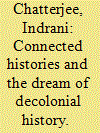

|
|
|
|
|
| Summary/Abstract |
This essay argues that historians in post-colonial nation-states and spaces cannot offer connected histories across spaces shaped by war and the partitions of the nineteenth and twentieth centuries. It provides examples of these hurdles from a space called ‘Assam’ in the nineteenth- and twentieth-century colonial archive. Native scribes collaborated with colonial Britons in writing accounts that set up spaces as culturally separate and disconnected from erstwhile hegemons. The essay concludes that connected histories of pre-colonial pasts remain a dream in a post-colonial context shaped by global and local investments in mythologised spaces, governing ideals and culturally separatist institutions.
|
|
|
|
|
|
|
|
|
|
|
|
|
|
|
|
| 2 |
ID:
179889
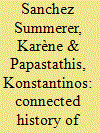

|
|
|
|
|
| Summary/Abstract |
The special issue critically explores, at a micro and macro level, the structural role and religious, cultural and political interactions of the Greek-Orthodox, Melkite and Syriac communities in late Ottoman and Mandate Syria and Palestine. It seeks to identify archival gaps, and to link the study of the micro-scale level of everyday cultural and religious life to the macro-narratives of global change affecting Christian communities, in a connected perspective, via dynamics of cultural and religious personal and institutional interactions. The Christian communities, both as institutions and lay bodies, are of special interest for the field of Levantine studies, since they were placed at the heart of the local power game, expressing the quest for social emancipation, while also keeping close links with diplomatic actors, colonial institutions, and foreign religious agents. The research presented lies on the idea that the communities in focus were inextricably linked, being actors operating within the same multi-ethnic periphery, having the same legal status, and being in contact to foreign agents, while at the same time politically dependent to the centralized ottoman and mandatory authorities.
|
|
|
|
|
|
|
|
|
|
|
|
|
|
|
|
| 3 |
ID:
144212
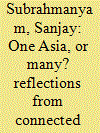

|
|
|
|
|
| Summary/Abstract |
In recent years people have been saying that the next century will be the century of Asia and the Pacific, as if that were sure to be the case. I disagree with this view. If we exclude the United States, the only countries in the Asia-Pacific region that are relatively developed are Japan, the ‘four little dragons’, Australia and New Zealand, with a total population of at most 200 million. (. . .) But the population of China and India adds up to 1.8 billion. Unless those two countries are developed, there will be no Asian century. No genuine Asia-Pacific century or Asian century can come until China, India and other neighbouring countries are developed. By the same token, there could be no Latin-American century without a developed Brazil. We should therefore regard the problem of development as one that concerns all mankind and study and solve it on that level. Only thus will we recognize that it is the responsibility not just of the developing countries but also of the developed countries.
|
|
|
|
|
|
|
|
|
|
|
|
|
|
|
|
| 4 |
ID:
187761
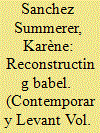

|
|
|
|
|
| Summary/Abstract |
How was missionary knowledge received and interpreted by scholars and church historians in Europe and Russia? Many late nineteenth and early twentieth-century academics utilised knowledge production from Christian missions, notably by way of scholarly Orientalism. However, the history of this knowledge is also a history of representations: while missionary knowledge helped showcase the cultural and religious traditions of Eastern Christianity, what were the underlying motives and especially the consequences? This article examines the formulation and circulation of Eastern Christian knowledge on either side of the Mediterranean, especially on the basis of Catholic missionary archives and academic productions, the study of which is sometimes rooted in non-Anglophone academic traditions. The aim is to shed light on how knowledge relating to Eastern Christianity was assimilated in Europe, as well as the role missions played in this process, especially from the last third of the nineteenth century, when the institutions and instruments for the circulation of knowledge emerged. Another objective is to address the circulations and transformations of this knowledge on either side of the Mediterranean: collected and developed in major European libraries and universities, it was integrated by the governance structures of churches, but quite often also returned to the space it originated from, where it was reappropriated and gave rise to patrimonial processes, notably alongside the sometimes tragic experiences of certain communities during the end of the Ottoman Empire and the establishment of new states. Christian missions, at the intersection of East and West, were at the heart of this dynamic .
|
|
|
|
|
|
|
|
|
|
|
|
|
|
|
|
| 5 |
ID:
144213
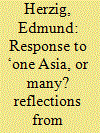

|
|
|
|
|
| Summary/Abstract |
The idea of Asia as a unity has appealed both to Europeans interested in differentiating themselves from a threatening, if inferior, Asiatic ‘other’, and to Asians keen to mark their distance from an alien and alienating Europe and West. For both groups, Asia is a useful term of alterity, although the place of ‘us’ and ‘them’ is reversed. Near the beginning of his lecture Sanjay Subrahmanyam remarks that, ‘in the play between the -emic and the -etic, the insider's and the outsider's perspective, a concept like “Asia” falls decidedly on the side of the -etic’. This point is reinforced by the fact that the European concept of Asia goes back to the Ancient Greeks (as Subrahmanyam notes), whereas the interest of Asian insiders in the concept of a homogeneous Asia is a modern phenomenon, a reaction against the assumption of superiority inherent in Western imperialism and neo-imperialism. In the case of both the European and the Asian conceptions, however, it is the viewpoint of the observer, rather than the empirical features of what is observed, that gives shape and meaning to the concept. I will use this short response to take a look at Asia from a third perspective, one that is neither fully ‘insider’ nor ‘outsider’ in character, namely that of the early modern Armenians, whose travels took them across the length and breadth of Asia, and Europe too.
|
|
|
|
|
|
|
|
|
|
|
|
|
|
|
|
|
|
|
|
|